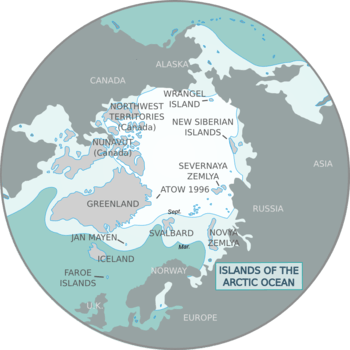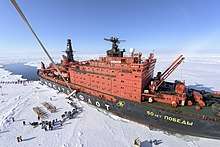North Pole
The North Pole is Earth's northernmost point, located in the middle of the Arctic Ocean.
- For other places with the same name, see North Pole (disambiguation).

Understand
The geographic North Pole is in the northern hemisphere at the Earth's axis of rotation, latitude 90°N (longitude not applicable). While the South Pole is on the continent of Antarctica, the North Pole is (as of the mid-2010s) covered by a sheet of shifting ice on the Arctic Ocean. Like the South Pole, the precise location of the North Pole is constantly shifting due to shifts in the Earth's axis of rotation.
There are no man-made structures marking the North Pole, as the ice moves from year to year.
While many explorers have tried and failed to reach the North Pole, it is now within reach for commercial tourists.
There is also the North Magnetic Pole. One definition is the point on the surface that magnetic compasses point to, following the Earth's geomagnetic field. Another uses the Earth's more broad magnetosphere (which affects the Aurora Borealis) as a reference. These positions drift, and are currently off Ellef Ringnes Island (one of the Queen Elizabeth Islands in Nunavut, Canada), and off Qaanaaq, Greenland, respectively. It is also subject to reversals on average about once every 500,000 years.
A somewhat arbitrary definition is the Northern Pole of Inaccessibility, the farthest point from any coastline. This is a fixed location (barring major sea level changes that might redefine coastlines) at 84°03'N 174°51'W.
A few locations further south use North Pole-related names to promote Santa Claus-themed attractions... and then there's the Northern Pole of Cold, in Russia, as the coldest region in the Northern Hemisphere.
Get in

The North Pole can only be reached on expeditions specifically mounted for the purpose. Most travel primarily by air, sometimes with a component traversing the last leg of the journey on the ice. The other alternative is traveling by boat, on an ice-breaker cutting through the Arctic Ocean.
The First
On April 9, 1909, Robert Peary, his partner Matthew Henson, and four Inuit reached the North Pole. They are recognized as the first, although there is still controversy surrounding this claim, as some believe the men missed the North Pole by several miles.
By air
Most expeditions take place in April when the Arctic night is over but the winter ice is still strong. They start from Longyearbyen in the Svalbard islands, and continue on to the Pole by a combination of plane and helicopter. They usually stop at the Russian polar research station and "ice airport" Barneo (also spelled "Borneo") which is set up each spring at about 89°N and drifts on the Arctic ice pack. Some expeditions drop travelers here or somewhere else short of the Pole itself, leaving them to finish on the ice. A less demanding and more affordable option are flying sightseeing expeditions starting in Germany or the UK, using a long-haul aircraft to overfly Norway, the Svalbard Archipelago, and the North Pole itself, without landing but flying low over areas of interest.
- Arctic Direct. Their North Pole Odyssey generally follows the routes of history's famous polar explorers, such as Dr. Frederick Cook who claimed to be the first to Pole in 1908 and Commander Robert E. Peary who claimed to be the first in 1909. The trip heads north via the Magnetic North Pole, Eureka and Nansen Sounds, and Ellesmere Islands, Cape Columbia. The return south incorporates Etah, Greenland, where Peary collected his Inuit support teams. A seasoned polar escort leads the Odyssey.
- Arctic Odysseys. Offers multiple excursion. Travel via helicopter, plane, icebreaker, dog sled, skiis, or a combination for a celebration at the North Pole. Make a phone call from the Pole, enjoy a Pole barbecue, or take a dip in the frigid waters before returning shipboard or to your Arctic expedition camp.
- Global Expedition Adventures. Offers a variety of packages, including plane/helicopter directly to the Pole, overnighting at the Pole, skiing "the last degree", and even skydiving onto the polar ice cap. You will typically be looking at a minimum of US$12,000 per head for the trip.
- Icetrek. Offers day-trips from Longyearbyen, 3-4 day excursions overnighting at Barneo, and skiing expeditions up to 9 days on the ice. €7,900–13,900.
- Northwest Passage. Offers packages including plane/helicopter flights all the way to the Pole, last-degree skiing, and dogsledding to the Pole.
- Voyage Concepts . Offers a five-day excursion by air, and a two-week (including training) expedition skiing the last leg of the way and flying back. Departs from London by way of Svalbard. £12,000 and up.
- Polar Challenge. Offers the opportunity to take part in a 350 nautical mile competitive team Polar race to the Magnetic North Pole and beyond. Includes full pre-race training in Wales, Austria and the Arctic, equipment and full administrative support. Entry fee £17,500 per person.
- North Pole Adventures. Offers standard as well as not so standard North Pole packages from special honeymoon deals to overland ski crossings to vodka tasting at 40 degrees below zero. Flights take off from Moscow and Frankfurt. Trips average about €10,000 per person, although honeymooners enjoy a two for the price of one deal.
By sea

There are two commercial sea vessels making regular trips to the North Pole, the nuclear-powered Russian ice-breaker Yamal, and 50 Years of Victory, operated by the Murmansk Shipping Company. They depart from Murmansk (tour packages beginning in Helsinki and in Moscow), making several two-week journeys in the Summer (when the ice is easier to get through). Yamal is equipped with 50 cabins and suites with private bathrooms and exterior windows, fine dining, heated indoor pool, gym, library, etc. 50 Years of Victory, the largest icebreaker ever built, has 64 cabins in five categories. Voyages are booked by a variety of tour operators (including some of the air-excursion outfits, plus several others), generally at about US$18,000–25,000 per person (double occupancy).
Get around
Crosscountry skis and dogsleds are about the only viable transportation option near the North Pole; staying with your tour group is advisable.
See
.jpg)
The ice terrain at the North Pole tends to be rather flat, though some interesting formations of snow and ice can be found. There's only one protracted sunrise and sunset each year (which will not be during your visit). Tour operators stick a sign pole into the ice, but that's unofficial and purely for photographic purposes.
Despite their name, polar bears don't usually venture this far north (preferring the southern "coastal" parts of the Arctic ice cap, with better swimming opportunities.)
Do
There are few formal recreational opportunities at the North Pole. Each year, however, there is a marathon foot race called the North Pole Marathon organized by Polar Running Adventures.
Adventurous types may try searching for Santa Claus but it is highly unlikely you'll be able to locate him, even if the blizzards which are common in most areas happen to clear for a while. That hasn't stopped the Arctic Circle city of Rovaniemi, Finland and the nearly-Arctic Interior Alaskan city of North Pole from promoting themselves as Santa's home; a few points further south also use North Pole or Santa Claus to promote Christmas-themed attractions.
Buy
There are no shops at the North Pole; you should bring everything that you might need for your expedition.
Eat
.jpg)
You or your tour operator will have to bring along all of your food. Celebratory caviar is traditional upon arriving at the Pole itself.
Drink
The North Pole's ocean-formed ice contains salt, making it unsuitable for drinking, even when thawed. BYOB. Celebratory champagne is traditional; vodka at -40° while standing on an iceberg is also quite appropriate.
Sleep
Although there are no permanent accommodations at or near the Pole, temporary camps can be set up, providing heated shelter for one or more nights. Barneo has semi-permanent heated shelters, which are commonly used by expeditions spending more than a day on the ice. See travelling in cold weather.
Connect
Any system based on geosynchronous satellites (which orbit the equator once a day) will not work. Even if the satellite is due south, it drops below the horizon near 80°N. This line corresponds to the middle of Ellesmere Island in Canada and northern Svalbard.
An Iridium satellite phone may work, Globalstar will not.
Go next
All visitors to the North Pole head south after their stay, typically back to the same location that they arrived from.
If you want to visit something similar, go to the South Pole in Antarctica.